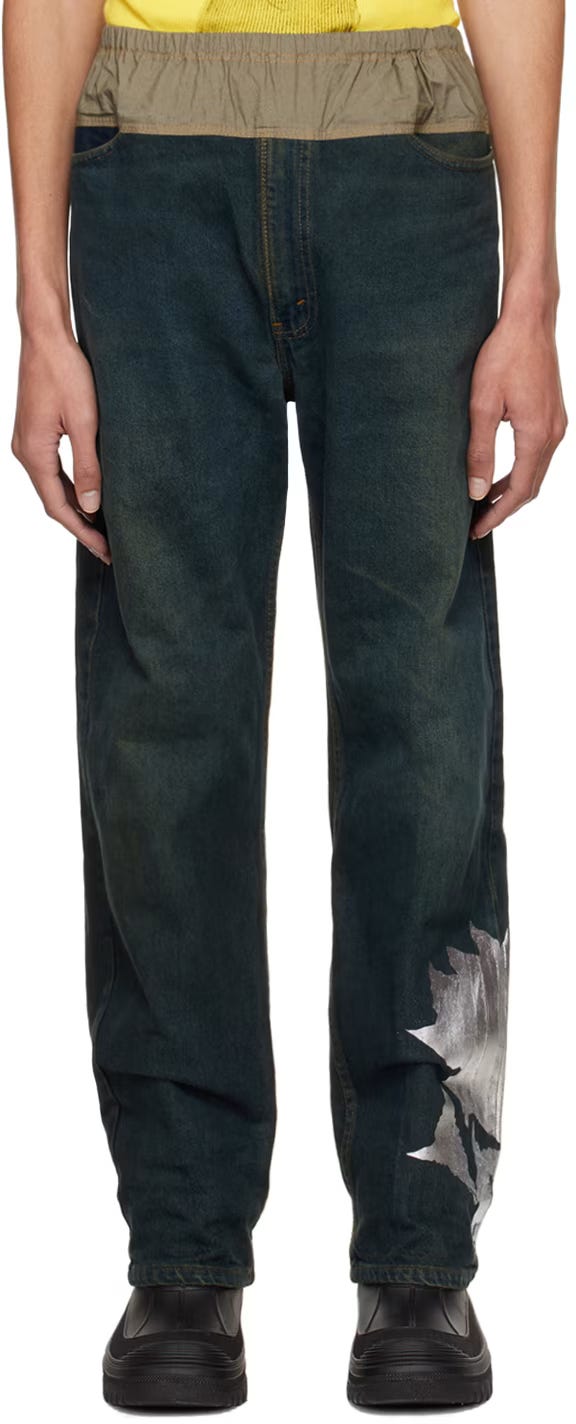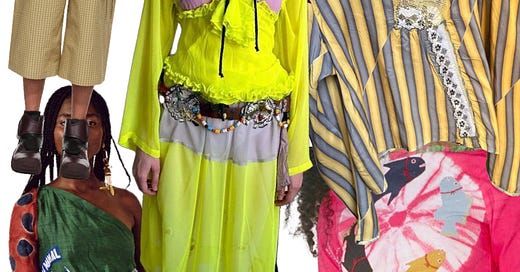CAPTCHA Clothing
A new wave of brands making clothing that can't be parsed—made for human consideration, not binary computation.
Hi! It’s not wrong or bad or even boring, IMHO, to use AI in the creation of art. One time, I wrote a piece for [redacted], used ChatGPT to beef up a single, tricky paragraph, and my editor proceeded to single that one out, gushing that it was perfect for the essay. Ouch and serves me right. In fashion, generative intelligence helped produce the SS24 collections of Collina Strada and Helliot Emil, who “fed images of previous looks into a gen-AI tool to produce new designs that could be refined with text prompts,” while Revolve and Desigual released limited capsules designed nearly in full by AI.
These collections have just as much potential to look great or flop as do collections with no artificial intelligence used in their creation, but as we veer farther and farther into the territory in which it’ll be hard to understand what is made how, not to mention why, it’s worth examining a wave of brands that continue to create clothing that functions like a CAPTCHA: they’re juuuust off-kilter, hazy, abject, or uncanny enough to require a mind capable of internalizing ambiguity and embedded conflict, stuff half-baked, stuff that can’t be easily coded into a binary system. I’m not talking about protective gear, like anti-facial-recognition tech, I’m talking about clothing from brands that share a certain ineffable, inscrutable need for human interpretation in their designs and material outputs.
If you like these posts, please let me know by liking and commenting here or on HR’s Instagram, subbing to the HR Substack (this) for free, getting bonus posts for seven bucks a month, or for ZERO DOLLARS, share (tag me if on IG so I can see and thank you)!
If you cannot afford the $7/month, I totally understand—respond to any of my email sends and I will get you a $2 subscription or comp you, whatever you need. HR is for everyone!
Thank you SO MUCH for your support, whatever you are able and willing to do to help is extremely valuable to me and I’m honored to be a small part of your life on the web.
While conceptualizing this post, I realized that these, coincidentally or not, are my favorite brands, by far. If I could only wear one single brand for the rest of my life, it would be SC103. Beyond its prolific, seemingly cumbersome and impractical (but still painfully covetable) links totes, the brand has been deemed “extremely offline” due to its reactionary bent against the large contingent of today’s clothing that’s meant to be viewed in 2D, on social media or in photos. SC103 isn’t making homesteader garb or luddite uniforms, and the influence of congealed concepts and ways of thinking that trickle down the internet are clear in the clothes—they’re just not made to be converted into code/pixels, they take the code and divorce it from the machines that interpret it. A CAPTCHA might be generated by a randomizer, but it’s explicitly intended to be processed not by a machine, but by a human.
Photos via the SC103 Instagram of its recent in-person-only pop-up shop in NY demonstrate the ways in which its garments defy a simple scan, an easy conversion into legible data:
The too-short sleeves, the muddy, over-stitched placket, the red thread…
…the enormous collar, asymmetrical pieces of errant lace down the front, shoulders interrupted by seemingly random fabric…
…the sailor silhouette with overwrought but abstract front detailing…
…the unfinished, accidental-looking collar, the sweatshirt material, the mom-ish shades of tie-dye…
…the hypnotic stripes quilted over like a topographical map, the cobalt buttonholes, the off-kilter piping…
All of this clothing seems a bit randomly generated, with bizarre choices of adornment, dizzying patterns and textures, abrupt cuts and angles, and aggressive construction tactics, but when viewed as gestalt pieces, they all project a compelling air that melds childlike craftiness with adult nuance, and they all demand to be worn, not just photographed. When worn, SC103 pieces might be rendered sexy, or silly, or solemn—through their interactions with the human bodies that wear them and eyes that perceive them, these garments are contextualized into making sense, even if they don’t on the rack. Also from the SC103 Instagram:
A neon yellow, nylon-looking blouse with frilly cutouts around the breasts and an athletic-style cinching neck is ridiculous on paper, but turns into something like the sacred garb of an otherworldly camp counselor/princess when worn, especially with a crafty, beaded low-slung belt.
Another outfit that’s almost impossible to describe in words—is that a spiral cummerbund? A lace-and-flannel dress? Chef-style checkered pants? Pale blue shoes with ruffles like the chest of a perverted tuxedo shirt? An Old World-style feathered bag? But together, the eye can render this all into an outfit notable for its earnestness and humanity. There’s something that rejects cynicism about clothes that could be randomly generated, but not computationally “solved.” What I’m trying to say is these clothes are the opposite of what you’d expect to see in an encyclopedia entry for “clothes.”
This hard-to-define “style” can manifest as ultramodern, but there’s always a rustic awkwardness about its construction. It might skew feminine or masculine, but there’s an inherent, contemporary gender neutrality infused into its conception, just because each garment feels like it was created in a proverbial Garden of Eden, where every new object that springs into being is unprecedented and unsoiled by formulaic conceptions of what “clothes” should look like.
Other brands that I think fit into this style (and happen to be some of my favorites) are Tigra Tigra, 100% Silk, and This Uniform. Instead of writing more about something fundamentally impossible to capture sufficiently in words, I’ll share some shoppable pieces from those three brands + SC103 that I feel physicalize my idea of CAPTCHA clothing.
One last thing I’ll say is this “style” has recurring material motifs: plaid, patches, ruching, abrupt pattern/fabric changes, tie-dye, asymmetrical designs, and abstract quilting + embroidery. It all looks traditional, and there is definitely influence from different cultural caches present in these pieces, but they ultimately look like objects from a tradition that doesn’t (yet) exist. It could be kitsch if it wasn’t so firmly planted in an understanding of the fashion of the near future.
SC103









Tigra Tigra





100% Silk




This Uniform


What do you think of this style/what name would you give it?
Hope your day is going well so far!
<3 HR











